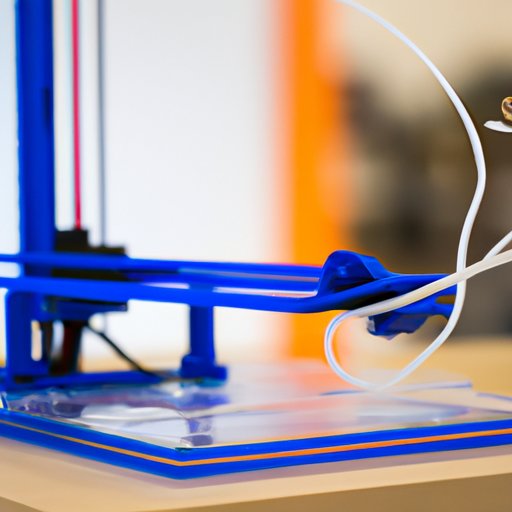I. Introduction
Creating a prototype for an invention is an exciting but challenging task. Many inventors struggle to turn their ideas into a tangible product that can be tested and refined. However, having a successful prototype is crucial in proving the feasibility of an invention and making it a reality. This article provides a step-by-step guide and offers various approaches to help inventors create prototypes that can lead to success.
II. Step-by-Step Guide
Before jumping into creating a prototype, it is important to have a plan or guide to follow. Here are the steps involved in creating a successful prototype:
1. Define the problem and purpose of the invention
Identify the problem that the invention will solve and determine its purpose. This will help inventors stay focused on the end goal and ensure that the prototype is aligned with the invention’s purpose.
2. Sketch out ideas and design concepts
Create sketches and design concepts of the invention. This will help to visualize the product and refine the design as needed.
3. Gather required materials and tools
Determine the materials and tools required to create the prototype. This may include wood, metal, plastic, or other materials, as well as hand or power tools.
4. Create a rough prototype
Create a basic, rough prototype of the invention using the gathered materials and tools. This will provide a tangible product to test and refine.
5. Refine and test the prototype
Test the prototype to identify any problems or areas of improvement. Refine the design as needed to improve the function and usability of the product.
6. Repeat as necessary until the final prototype is achieved
Continue to refine and test the prototype until the final product is achieved. This may involve multiple iterations and adjustments until the product is ready for production.
III. DIY Approach
Taking a do-it-yourself (DIY) approach to creating a prototype has its benefits and drawbacks. While it may be cost-effective, it can also be time-consuming and may require more skill in materials and tool usage. Here are tips and tricks for creating a prototype from scratch:
1. Starting with simple materials and building up
Begin with simple materials and build the prototype up as more skills and resources become available. This can help to refine the idea and identify solutions as the product takes shape.
2. Using online resources and tutorials to learn new skills
Utilize online resources such as tutorials and forums to learn new skills and techniques in materials and tool usage.
3. Staying organized and focused throughout the process
Stay organized and focused during the creation process. This will help to identify problems and solutions, and keep the project moving forward.
IV. Technology-Focused Approach
Using technology to create a prototype, such as 3D printing and CAD programs, can offer significant benefits, including faster production, higher accuracy, and greater customization. However, it can also be cost-prohibitive and require additional skills. Here are tips for inventors interested in using technology to create their prototypes:
1. Researching and investing in the right technology for their needs and budget
Research and invest in the right technology for the project’s needs and budget. Consider renting or borrowing equipment if necessary.
2. Learning how to use the technology correctly
Learn how to use the technology correctly, and invest time in learning new tools and techniques as they become available.
3. Staying up-to-date with new advancements in the field
Stay up-to-date on the latest advancements in technology and materials. This will help inventors identify new solutions and techniques to incorporate into their projects.
V. Problem-Solving
Inventors may encounter common problems and challenges when creating prototypes, such as not having the right materials or tools, struggling with design and concept development, and running into technical issues. Here are some solutions and tips for overcoming these challenges:
1. Researching and sourcing the right materials and tools ahead of time
Research and source the right materials and tools needed for the project ahead of time. This will help to prevent delays and ensure that the final product is functional and durable.
2. Consulting with experts or seeking out mentorship
Consult with experts in the field or seek out mentorship to gain insights and solutions to common problems.
3. Staying patient and persistent throughout the process
Stay patient and persistent throughout the process. The creation of a successful prototype may take time and require multiple iterations to fully achieve its purpose.
VI. Inspiration and Creativity
The creation of a successful prototype requires inspiration and creativity. Here are some tips for inventors:
1. Brainstorming and idea generation exercises
Engage in brainstorming and idea generation exercises to spark creativity and identify potential solutions.
2. Collaborating with others or seeking out feedback
Collaborate with others or seek out feedback from peers and experts. This can provide fresh perspectives and help to refine the invention.
VII. Case Study
A specific invention, created by ________, provides an ideal case study for the prototype creation process. Despite encountering several challenges and obstacles to create a non-invasive device to treat hypoglycemia, the inventor persisted and successfully created a prototype. Through trial and error, the inventor identified the critical aspects of the device and refined the product until its purpose was fully achieved.
VIII. Conclusion
Creating a successful prototype for an invention requires planning, dedication, and creativity. This article has provided a step-by-step guide and various approaches, including DIY and technology-focused, to help inventors create prototypes. It has also offered solutions for common problems and encouraged inventors to remain patient and persistent throughout the process. With the tips and advice provided in this article, inventors can take the first steps towards turning their ideas into tangible products that can lead to success.
(Note: Is this article not meeting your expectations? Do you have knowledge or insights to share? Unlock new opportunities and expand your reach by joining our authors team. Click Registration to join us and share your expertise with our readers.)
